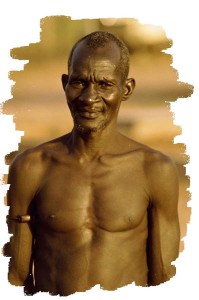 From: TUBOB: Two Years in West Africa with the Peace Corps
From: TUBOB: Two Years in West Africa with the Peace Corps
In the many huts I entered, if there were pictures at all, they were portraits of people, never scenery or artwork. Many huts had no pictures. In a poor country, pictures are a luxury.
My husband’s parents frequently sent us several developed prints made from Bruce’s slides. We didn’t see the slides ourselves, since we had them sent from Kodak directly to the folks. It was always wonderful to see our pictures. Normally those prints his parents sent were some of the best ones that they thought we should see. In some cases, we’d asked them to send us extra copies so we could give them to our Gambian friends.
The folks sent us an exceptionally good portrait of our good friend Tombong, shirtless and muscular. Taken in the evening light, the picture had an unusual golden glow. We decided to have it framed.
We found the Gambian method of picture framing unique. They cut pieces of glass somewhat larger than the picture. In this case, we mounted Tombong’s picture on a piece of blank paper. The framer encased the mounted picture between two pieces of glass and then skillfully taped the glass together with red electrical tape. Then, the framer hand painted flowers in each corner, giving the appearance of a frame. As he did this, a crowd gathered to see what the tubobs were doing.
“Tombong,” I heard many people murmur. Probably two dozen people had gathered to watch the picture framer at work.
That was at the end of a day. We wondered how long it would be before word got to Tombong.
The next morning I saw him coming our way, his steps very quick. He rarely walked that fast. As we greeted one another, I could see his eyes dart to our walls.
“We have something for you, Tombong.”
“Yes.” Though old by African standards, Tombong showed the anticipation of a child at Christmas.
Bruce handed him the picture, wrapped in brown paper. I was surprised to see tears spring to Tombong’s eyes when he opened the package. “Oh, my. Oh, this is fine. Now I will have something to give to my son. He looked at each of us in turn. “Thank you, thank you.”


I love this story. I love the power of photography, how can touch the heart, and the cultural quaintness of the picture frame treatment. Well done, Mary.
This was an unusual photograph. Tombong was very dark–almost blue-black–but for some reason he looked golden in this photo. This is a fond memory for us. Thank you for your comment.
This story shows so profoundly the difference between cultures.
It certainly does, Judy. In our society we take so much for granted.
What a sweet story. Fascinating to learn about the Gambian “framing!”
That is such a marvelous story, perfectly told! Thank you for writing it.
Thank you, Carol. It was an interesting picture. Tombong was very dark–almost blue-black and the picture turned out with him looking so golden.
Thank you, Doris. Gambians are very creative in making do with very little.